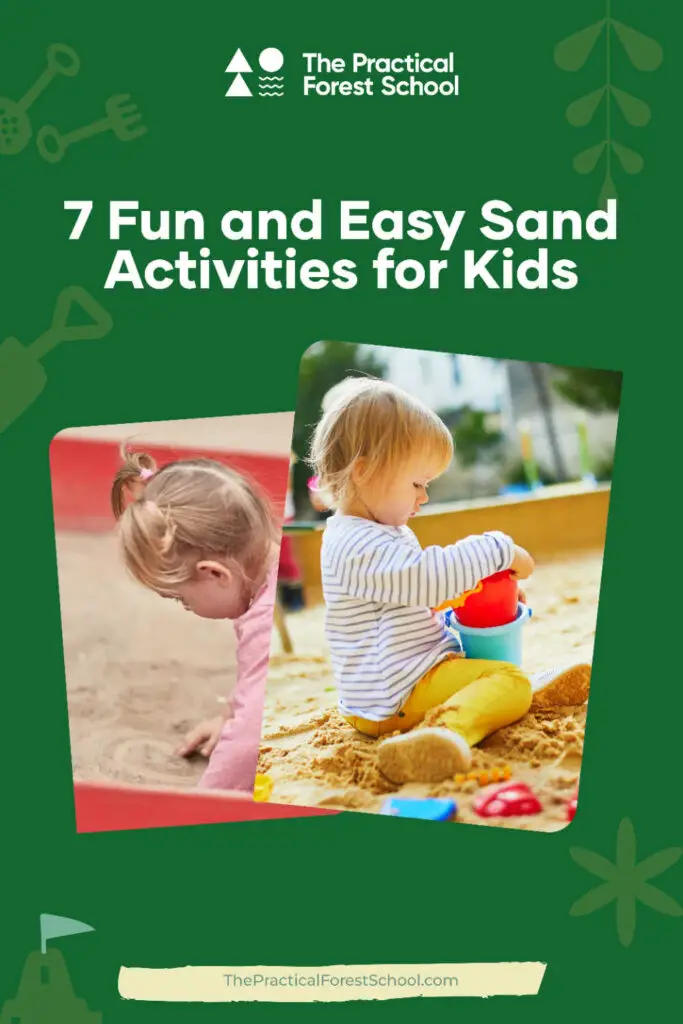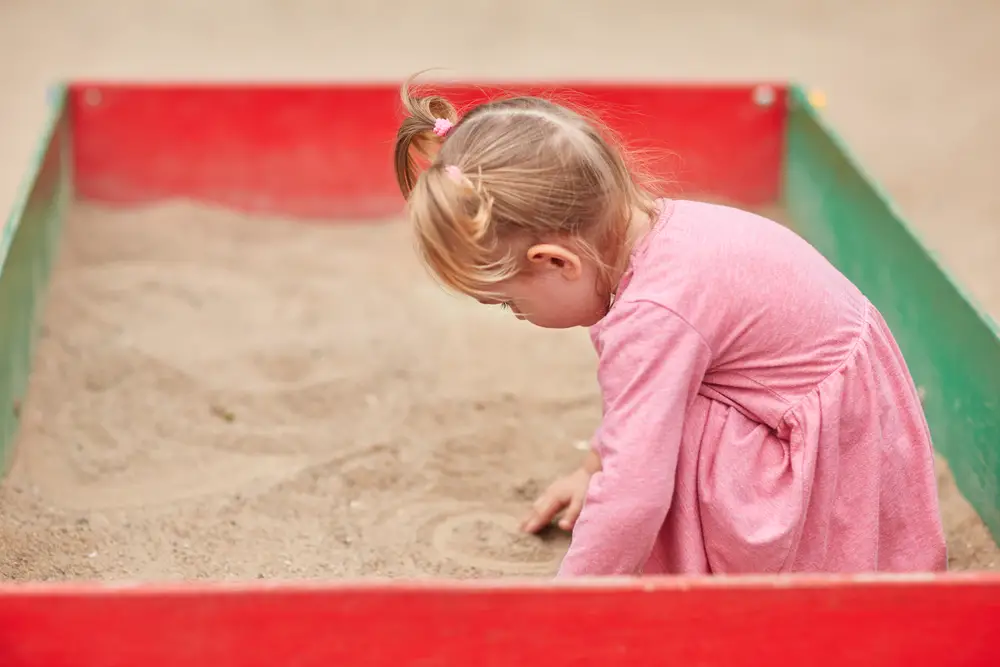Exploring the Benefits of Sand Play for Early Years Education (Plus Activities)
This blog is reader-supported. When you purchase something through an affiliate link on this site, we may earn some coffee money. Thanks! Learn more.
This article contains affiliate links at no cost to you.
Sand play is an important part of early years education, and it has been proven to have a number of benefits for young children. Whether you’re looking for summer activities that will keep your preschoolers entertained or just want to know what equipment you need to get started with sand play, this article will provide the answers!
We’ll discuss why sand play is so beneficial in early years development as well as look at some fun types of activities that can be done in the sand. Plus, we’ll give tips on setting up an outdoor area specifically designed for sand play.
Sand play doesn’t have to come with the headache of dirty socks, buried toys and – sigh – throwing handfuls of the stuff at friends. Read on and we’ll show you how to make it work in your setting!
Benefits of sand play for early years
Personally, I’ve never been a fan of sand. Even as a child, I didn’t like getting it between my toes, and brushing it off after a beach day was horrible.
But playing with sand is a highlight of the day for many children, and there are lots of benefits.
Here are some of the sand play benefits for preschoolers and young children.
Cognitive development
Sand play can help to improve a child’s problem-solving skills by allowing them to explore different materials and objects. It also encourages creativity as they experiment with different ways to combine items together.
Through this process, they learn about cause and effect relationships while developing their fine motor skills.
Physical development
Playing in the sand provides opportunities for gross motor development such as running, jumping, digging and scooping which all help build strength and coordination. It also encourages balance when climbing on rocks or logs that may be used during sand play activities (not sharp ones though — be careful about what you offer).
Socialisation and community-building
Sand play provides an opportunity for children to interact with one another while playing cooperatively or competitively, depending on the activity. This type of interaction helps foster communication skills such as turn taking and sharing ideas, which can lead to improved self-esteem due to feeling successful from completing tasks with their classmates and friends.
Sand play offers a variety of benefits for early years development, from cognitive to physical and social-emotional. Next, let’s talk about how sand play can be used as part of outdoor education for forest school leaders.

Sand play and forest school
Putting a sandbox in your forest area isn’t what we would consider ‘proper’ forest school. The sand isn’t naturally there in the woodland, normally.
However, beach schools would have unlimited access to sand! And outdoor education TAs might choose to use sand play as part of their activities. Personally, I’m open to all kinds of outdoor play. If it gets kids outside, doing tactile activities and exploring the world, then that’s good for me.
We don’t have sand in our forest school area but we do have it in other settings in our preschool. As a forest school leader, educator or TA, you can make your own decisions about what’s right for your setting.
Sand play activities provide a great way for kids to explore their environment, use their imaginations, and construct with materials. But before you get started, you’ll need the right kit.
What equipment is needed for sand play?
You don’t actually need much equipment to set up an area for kids to play in the sand. As a minimum, you’ll need somewhere to put the sand and sand.
A sandbox or tray is the first piece of equipment needed for sand play. Sandboxes come in many shapes and sizes, from small plastic containers to large wooden boxes that can fit several children at once. Our local primary school has a sandpit like this, with a lid – but that scale of equipment is best suited to a permanent location. You’ll need space to allocate to a permanent sand fixture.
If you don’t have access to a sandbox, you can also use a shallow tray filled with sand instead. We have a tuff tray that is useful for small amounts of sand. Children can use it to trace letters and make patterns, but you can’t really bury anything in such a shallow area.
Next, the sand.
People sometimes ask us if play sand is toxic. It’s not, or it wouldn’t be marketed as suitable for children’s play, but do check that the sand you get is non-toxic and suitable. A parent offering a load of sand from the building site where they work is probably going to be a no go.
The next item on the list is sand toys and tools. These items help encourage imaginative play and creative construction projects in the sand. Examples include shovels, buckets, sifters, moulds, rakes, scoops and other digging tools as well as figurines like animals or people for pretend play scenarios.
You may also want to add some natural elements such as shells or rocks for added texture and interest in your sandbox area. They are good for counting, burying, stacking and decorating.

Adding different materials such as shells or rocks will give kids even more opportunities for creative exploration during their time spent outdoors playing in the sandbox area.
Finally, it’s important to remember that water is an essential part of any successful sand experience! Water helps bring life into the box by allowing kids to mix colours together while they build castles or create rivers between their islands – not only does this make playing more fun but it also encourages problem-solving skills too!
Having the necessary equipment set up before you introduce children to the activity will mean they can get started straight away. Don’t forget that before you introduce anything new, you’ll need to risk assess the activity.
Having the right equipment and adequate risk assessments will create a safe and engaging environment for everyone to explore and learn in.
Setting up an outdoor sand play area for early years education
You’re ready to set up your outdoor sand play area in an early years setting, but before you get started there are several considerations to keep in mind. Location is key when it comes to creating a safe and accessible environment for children.
Consider the amount of shade available, as well as wind protection if needed. Make sure that the sandbox or tray is placed on level ground and is accessible so it can be enjoyed by all.
Sand isn’t a dangerous item to have in your setting, but you’ll need to provide supervision by an adult or trained educator at all times while children are playing in the sand. In particular, help children understand the rules of play (the most important for me is not to throw the sand!).
Make sure that any toys used are age-appropriate and clean before use, and that any materials such as mini figures, cars, rocks, shells and so on, have been properly sanitized beforehand too according to your protocols.
Types of sand play activities for preschoolers and young children
So what do you do with the sand? Here are some easy sand activities for children from 1 and 2 years old upwards.
Sensory exploration
Sand play can be a great way to engage preschoolers and very young children in sensory exploration. Activities such as sifting, scooping, pouring, mixing, and burying objects in the sand provide tactile stimulation for their hands and fingers. It also encourages them to explore different textures and temperatures of the sand. For example, they can feel how wet or dry it is or compare warm sand with cool sand.
When can babies play with sand? Babies can play in the sand from about a year old. If you run outdoor play sessions such as parent and toddler groups, you can incorporate sand play.
Imaginative play
Sand play activities are also great for imaginative play. Children of all ages can use their imaginations to create stories about what they’re doing in the sandbox – from pretending that they’re on a beach vacation to building castles like kings and queens. We often see children playing together and making up cooperative role-playing games.
For example, you could build it into an early years pirate activity: bury some treasure, make a map and have the children dig for what they can find. Tie it into a favourite story.
Construction and building
Finally, construction and building activities are another popular go-to. This could include anything from making roads with toy cars (and tunnels, if they’re a little older) to creating shapes out of moulds or buckets; all while developing important fine motor skills.
These types of activities help foster creativity as well as problem-solving skills by teaching kids how to think outside the box. They’ve only got sand and water – and whatever else you provide – so they have to be creative.
Read on for some more specific examples of sand activities that you can easily set up.
7 Simple activities to do in the sand
There are many simple activities that can be done with sand which require minimal equipment and resources. Here are 5 of our favourites.
1. Sand painting
Sand painting is an easy activity for toddlers and early years children to do outdoors. All you need is some coloured sand or powder paint mixed with the sand in a tray or sandbox.
Children can use their hands or tools such as spoons, brushes or sticks to create patterns and designs in the sand. This helps them explore different textures while also developing their fine motor skills through manipulating the materials.
2. Sand sculptures
With just a few basic tools such as shovels, buckets and moulds children can create amazing sculptures out of wet sand! They will have lots of fun digging into the wet sand creating shapes like castles, animals or whatever they imagine! This activity encourages creativity while helping build hand-eye coordination when using tools such as shovels to shape the material.
You don’t need to buy moulds. Any old cake or jelly moulds, or even (clean) plastic food packaging can be recycled into sand-sculpting equipment.
3. Mandalas
Mandalas are beautiful symmetrical designs created by arranging objects on top of a flat surface like paper or fabric but why not try making one out of dry sand? You could use shells, stones pebbles etc… arranged around a central point to make your own unique design – this would be great for older kids who want something more challenging. Give them a flat area and a small rake and see what they can create.
Not only does it look pretty but it’s also very calming too – perfect for those days when everyone needs some time out from all that running around!
There are so many more possibilities depending on what resources you have available, such as water tables, so get creative and be led by what the children seem to gravitate to wanting to do.
These simple activities are a great way to introduce children to the wonders of sand play and open up a world of creative exploration!
4. Baking
OK, you aren’t going to put these cakes in the oven. But bring the tea service out to the sand pit and have fun making meals.
5. Road races
Bring the toy cars to the sand pit and see how long it takes for kids to make some roads for them to race on. Think Disney’s Cars movie for landscape ideas: deep valleys, tight corners and dirt roads. Older children can use wet, compressed sand to make tunnels and arches.
Whether the kids want to race or just push the cars around the track, they’ll have a great time.
6. Buried treasure
If you have a group that loves pirates (or just digging), consider letting them know that there is treasure in the sand pit. Then offer spades and rakes and let them see what they can find.
If you have magnetic objects, the children can use magnet fishing rods or wants to see what pops up through the sand.
As a variation, bury some ‘dinosaur’ bones and go on an archaeological dig. Or paint some rocks gold (the children can take the lead on this) and then bury the ‘nuggets’. They can then go panning for gold and see how many nuggets they can find!
7. Letters
Our tuff tray doesn’t hold much sand, but it is useful for drawing. Invite the children to draw letters and numbers in the sand using their fingers or tools.
Common questions on sand play
What learning outcome is sandpit play?
Sandpit play is an important part of outdoor education, particularly in early years settings. It encourages children to explore their environment and develop their physical, social and cognitive skills.
Through sandpit play, children can learn about the properties of different materials, practice problem-solving techniques and gain an understanding of cause and effect relationships. They also have the opportunity to engage in creative activities such as building structures or making sculptures with natural materials found around them.
Sandpit play provides a safe space for learning that promotes self-expression, collaboration and experimentation – all key components for successful learning outcomes.
What is the benefit of sensory play with sand for toddlers?
Sensory play with sand offers a great benefit to toddlers. It helps them develop their fine motor skills, as they learn how to scoop and pour the sand into different containers. Sand also encourages imaginative play, allowing children to create castles or dig for buried treasure.
Additionally, it provides tactile stimulation which can help improve sensory processing and coordination in young children. Finally, playing with sand is an enjoyable activity that promotes social interaction between peers as they explore together and share ideas. All of these benefits make sensory play with sand an ideal activity for toddlers!
Is playing with sand a sensory activity?
Yes, playing with sand can be a sensory activity. It engages the senses of sight, touch and sound as children explore different textures and colors of sand. Playing with sand also encourages creativity as children create shapes and patterns or bury objects in the sand. Sand play also provides an opportunity for social interaction between peers when they share ideas or collaborate on projects together.
Why is sandbox good for children?
Sandbox play is an important part of a child’s development. It helps children learn to share, cooperate and problem solve in a safe environment. It also encourages creative thinking as they explore the different possibilities that the sandbox offers. Sandbox play can help develop fine motor skills, hand-eye coordination and sensory exploration as children manipulate objects such as sand, water and tools.
By engaging in these activities outdoors, children are exposed to nature which has been proven to have positive effects on physical health, mental well-being and cognitive development. All of this makes sandbox play an invaluable part of any early years or primary school education program for young learners!
Final thoughts
Sand play is a great way to engage young children in outdoor learning and exploration. It encourages creativity, problem solving skills, social interaction and physical development. With the right equipment and activities, sand play can be a fun and rewarding experience for both educators and students alike.

About the author: Elizabeth Borley
Elizabeth is our forest school administrator, responsible for running the website and managing bookings for afterschool clubs. She is a member of the Forest Childcare Association and loves walking in the woods and places with a view. As a parent, she understands the value of children spending time outdoors.